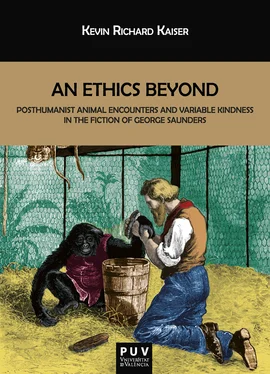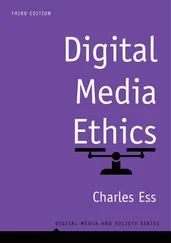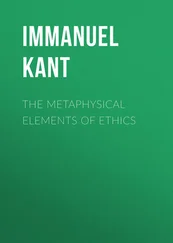It is no accident that the phrase “how we think” recurs throughout Wolfe’s What is Posthumanism? . 20If thinking is to remain active—if it is to avoid becoming orthodoxy, if it is to eschew doxa —then theory and philosophy cannot be harnessed and hidebound; however, this is easier claimed than done. Even the emphasis on thinking, which I have asserted thus far in this text, is worrisome. Although thinking need not be associated with the (humanist) mind, I prefer the terms sensing and feeling, which I feel are less troublesome by dint of their indistinctiveness. We feel and sense in multiple ways, and while we can reconceive our conceptions of what is or is not thinking, the term does carry the burden of its association with mind rather than body. Furthermore, while we may deploy the distinctions, forms, and procedures of the so-called discourse of species—or any other discourse, for that matter—we cannot reflect fully upon them from within the same system that produces them. Briefly, no matter how obvious this statement may seem, we cannot know what is concealed from us nor what we do not understand.
Posthumanism exists precisely because the faults in humanism’s procedures cannot be observed by humanism. If humanism were capable of this, it would no longer be humanism. For that, an “outside” observer is necessary. Wolfe’s suggestions that the observer need not be human is indeed the case with the little female cat in Derrida’s “The Animal That Therefore I Am (More to Follow)” (2013). 21It is also the reason why Wolfe calls on second-order systems theory as a complement to Derridean philosophy. For my purposes, I will adopt a specific field, literary fiction, to which posthumanist theory can be applied so as to make apparent imagined scenarios of what we might call ethical situations and how a posthumanist ethics might appear or occur—indeed, might confront us—in a text. In other words, rather than simply using theory to understand literature, literature can equally reveal to us more readily what remains dormant in conceptions of posthumanist ethics.
Placing valuable emphasis on literature, Pramod K. Nayar’s Posthumanism , describes critical posthumanism as “the radical decentring of the human sovereign, coherent and autonomous human in order to demonstrate how the human is always already evolving with, constituted by and constitutive of multiple life forms and machines ” (2013, 2, italics original). In Nayar’s text, posthumanism again centers on deanthropocentrism, which leads us to postanthropocentrism. However, his focus is on the role that literature plays in shaping ideas of the human. Since at least the Renaissance, certain literature has mandated and reinforced particular human behaviors, actions, reactions, and interactions. Nayar believes that literature is the field of humanism in which human “nature” might best be revealed and “in which the human is defined, described and debated,” while also serving as “the site where we can witness the Other and the different” (32). Literature is an immersive engagement. The very act of reading, Nayar contends, allows for engagement with the Other while questioning both “the nature and the limits of the Self” (32). It also cannot be construed strictly as mental exercise; it is a bodily experience that demands response.
By referring to the exercise as both mental and bodily, I do not intend a separation of the terms nor a union that implies a previous separation. Even the compound “mindbody” is not sufficient as a term. Language retains and reinforces conceptions of “mind” and “body” as inherited from a humanist knowledge system that has grounded them as opposites, with the former being privileged, so that it is indicated above and beyond the latter, which is denied a place in discourse other than to occupy a negative space. The import here is that mind and body are not, either of them, as such; they are monist. This is important in regards to thinking as well as reading.
Nayar asserts that reading engages us “in the immersive environment of a text with all its affective and sensuous constituents” (32). Reading is not just intellectual activity in the received sense of the mind as the site of knowing; reading is also visceral, a bodily knowing. In reading of and about the Other, we are also aware of a reading “self” (which is why writing about the Other is so dangerous in terms of how we perceive the Other). Through reading the Other in literature, we can engage with the Other. Nayar suspects, like other posthumanists, that whatever the human is, it is so only because of the Other. Better than continuing to label “the Other” by such a term, at this point it may be more helpful to sense others not as such but as constituents. By this I mean that “others” are participatory members in a community of beings that comprise a whole. For example, humans are comprised of various microorganisms, including bacteria, viruses, archaea, protists, and fungi. The human is given by and gives of (other) beings, whether they are, according to Nayar, living organisms or technology.
Before moving on, I think it is important to qualify the above claims, especially to clarify why I prefer “constituents” to the continued use of “the Other.” The path to this conclusion is nonlinear but is not a digression. The literary texts that demonstrate to us what the human is have traditionally revealed privileged, white male, human rationalist—or, to borrow Derrida’s neologism, phallogocentric—constructions of the human. Derrida goes one step further, of course, acknowledging the culturally accepted norm of flesh-eating as an integral feature of how the human has been though. Because of this, he understands the dominant subject as carnophallogocentric. According to Derrida, who intriguingly includes vegetarians—and assumedly vegans—in the prefix, human “culture rests on a structure of sacrifice. We are all mixed up in an eating of flesh—real or symbolic” (LD n.p.). 22For Derrida, the assimilation of a text is carnivorous in a symbolic sense, such that a deconstructionist reading of a text calls for “respect for that which cannot be eaten—respect for that in a text which cannot be assimilated” (LD n.p.). Derrida exhibits a clear theoretical standpoint, declaring that his “thoughts on the limits of eating follow in their entirety” the very schema as his “theories on the indeterminate or untranslatable in a text. There is always a remainder that cannot be read, that must remain alien. This residue can never be interrogated as the same, but must be constantly sought out anew, and must continue to be written” (LD n.p.). The carnophallogocentric subject dominant to Western culture has not respected the limits of eating, in this sense. It digests, or attempts to digest, all, including the alien, the Other.
Like Derrida, feminist, postcolonialist, and posthumanist philosophers have challenged the carnophallogocentric subject and its conception of the Other, which are conceived in dualistic terms: man/woman, colonizer/subaltern native, human/animal. In philosophy and psychology, the Other has been determined as a counterpart to the Self although the Other does not necessarily require another being. However, while I knowingly am generalizing and oversimplifying, both Other and Self often have been restricted to the human. This is problematic if the human has predominantly been assumed to be the subject, especially so if the subject is what Derrida calls carnophallogocentric. Therefore, to avoid unnecessary associations, I will refrain from utilizing “the Other” or even “the other,” except in instances in which I am examining how it has been used historically, in favor of the term “constituents,” which I find more favorable since it does not carry connotations of dualism and grants a sense of agency to those involved, which is as important for nonhuman beings as it is for human beings.
Читать дальше












